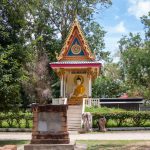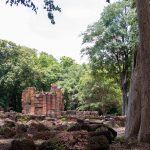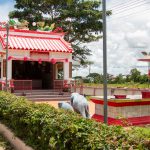Prasat Chom Phra











Prasat Chom Phra
Location : Ban Sri Dong Bang Village, Chom Phra Sub-district, Chom Phra District, Surin
Opening time : Everyday (no admission fees)
Website : www.finearts.go.th/surinmuseum
Prasat Chom Phra was a hospital or religious site of the hospital which is one of the 102 hospitals which King Jayavarman VII commissioned in the 18th Buddhist century due to the fact that he was a Buddhist devout of the Mahayana order and he also encouraged his subjects to follow suit. This changed the architectural aspect of the Khmer culture which used to be grand structures as per the principle in Hinduism construction to become a community service base architecture for the well being of his subjects according to Buddhist principles.
From all evidence and the inscriptions in all the hospitals it was found that King Jayavarman VII commissioned hospitals nationwide with the governors of each city made responsible and also to appoint medical personnel and procure medication to cater to the population’s ailments.
The architectural style of these hospitals are all similar which is a main building in the middle and a chapel to the right surrounded by a low wall and outside the wall to the northeast is a square-shape pond.
Prasat Chom Phra has one main building of laterite and the layout is a 5x 5 m. square with recessed corners and the entrance is in the eastern wall with a 3 x 2 m. bay. To the southeast is a library which is a 4 x 8 rectangle laterite building with an entrance facing west. The whole complex is surrounded by a low laterite wall rectangle in shape with an area of 21.60 x 45 m. and to the east is a gateway in the shape of a cross with a window next to it. Outside the wall to the northeast is a pond and from the excavation figures of Phra Vajrasattva and the head of Phra Avalokitsevara, the Bhodisattava who embodies the compassion of all Buddhas.
Era : Approximately 18th Buddhist century
Ancient Site Proclamation : Announced in the Royal Gazette, volume 52 section 75 on 8 March 1935 as a National Ancient Site.
Ancient Site Boundary Proclamation : Announced in the Royal Gazette, volume 98 section 104 on 30 June 1981, area of 28 rai 12 square wa. (44,848 sq.m.)
From all evidence and the inscriptions in all the hospitals it was found that King Jayavarman VII commissioned hospitals nationwide with the governors of each city made responsible and also to appoint medical personnel and procure medication to cater to the population’s ailments.
The architectural style of these hospitals are all similar which is a main building in the middle and a chapel to the right surrounded by a low wall and outside the wall to the northeast is a square-shape pond.
Prasat Chom Phra has one main building of laterite and the layout is a 5x 5 m. square with recessed corners and the entrance is in the eastern wall with a 3 x 2 m. bay. To the southeast is a library which is a 4 x 8 rectangle laterite building with an entrance facing west. The whole complex is surrounded by a low laterite wall rectangle in shape with an area of 21.60 x 45 m. and to the east is a gateway in the shape of a cross with a window next to it. Outside the wall to the northeast is a pond and from the excavation figures of Phra Vajrasattva and the head of Phra Avalokitsevara, the Bhodisattava who embodies the compassion of all Buddhas.
Era : Approximately 18th Buddhist century
Ancient Site Proclamation : Announced in the Royal Gazette, volume 52 section 75 on 8 March 1935 as a National Ancient Site.
Ancient Site Boundary Proclamation : Announced in the Royal Gazette, volume 98 section 104 on 30 June 1981, area of 28 rai 12 square wa. (44,848 sq.m.)
